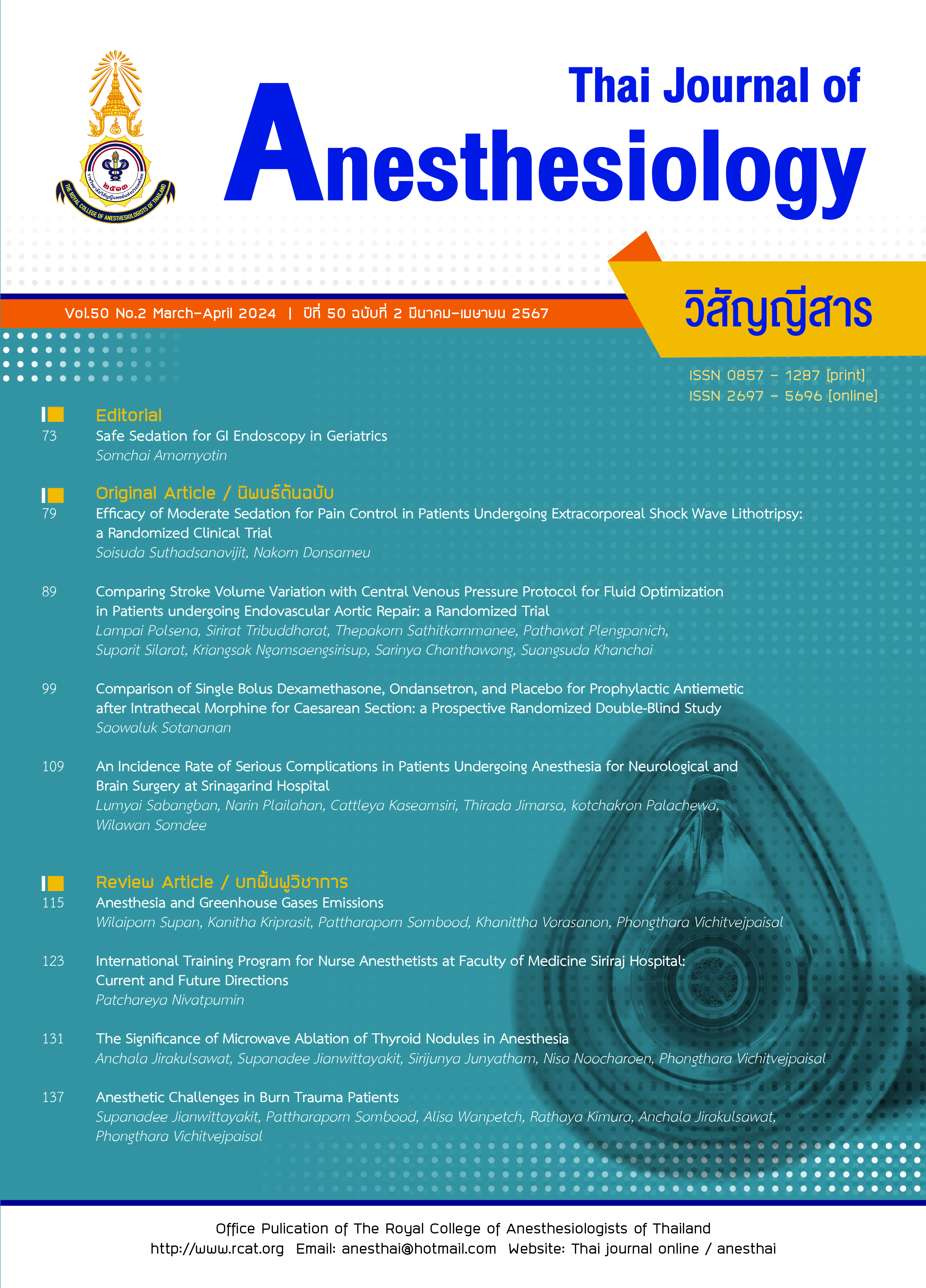Comparison of Single Bolus Dexamethasone, Ondansetron, and Placebo for Prophylactic Antiemetic after Intrathecal Morphine for Caesarean Section: a Prospective Randomized Double-Blind Study
Main Article Content
Abstract
Background: High incidences of nausea and vomiting (30-65%) after intrathecal morphine for patients undergoing caesarean section leading to patient discomfort, delayed mother-to-baby bonding, and aggravated postoperative pain could result in wound dehiscence, aspiration, or dehydration. This study aimed to compare the efficacy of the antiemetic effect between intravenous (IV) dexamethasone 5 mg, IV ondansetron 8 mg and a placebo in patients receiving intrathecal morphine for caesarean section. Methods: A prospective randomized double-blind study was conducted at Somdetphraphutthaloetla Hospital. Patients undergoing elective caesarean section were randomized to receive IV dexamethasone, IV ondansetron or a placebo. The primary outcome was an incidence of postoperative nausea in the first 24 h. Results: A total of 90 patients were analyzed by the intention to treat method. There was no difference in demographic data among groups. The incidence of postoperative nausea in 24 h as the primary outcome was 6.7% in the dexamethasone group, 6.7% in the ondansetron group, and 20.0% in the placebo group. There was no statistical difference in postoperative nausea in 24 h among groups. Incidences of postoperative vomiting, shivering, and pruritus within 24 h, postoperative tramadol consumption, postoperative pain score showed no significant differences. Adverse effects were not found in all groups. Conclusion: Both dexamethasone and ondansetron could potentially decrease the incidence of postoperative nausea within 24 h after receiving 0.2 mg of intrathecal morphine compared with a placebo effect. Although the reduction of incidence outcome had an NNT of 7.5, the result was not statistically significant.
Article Details

This work is licensed under a Creative Commons Attribution-NonCommercial-NoDerivatives 4.0 International License.
References
Abouleish E, Rawal N, Fallon K, Hernandez D. Combined intrathecal morphine and bupivacaine for cesarean section. Anesth Analg. 1988;67:370-4.
Abboud TK, Dror A, Mosaad P, et al. Mini-dose intrathecal morphine for the relief of post-cesarean section pain: safety, efficacy and ventilatory responses to carbon dioxide. Anesth Analg. 1988;67:137-43.
Dahl JB, Jeppesen IS, Jorgensen H, Wetterslev J, Møiniche S. Intraoperative and postoperative analgesic efficacy and adverse effects of intrathecal opioids in patients undergoing cesarean section with spinal anesthesia: a qualitative and quantitative systematic review of randomised, controlled trials. Anesthesiology. 1999;91:1919-27.
Vercauteren M, Vereecken K, La Malfa M, Coppejans H, Adriaensen H. Cost-effectiveness of analgesia after Caesarean section. A comparison of intrathecal morphine and epidural PCA. Acta Anaesthesiol Scand. 2002;46:85-9.
Gerancher JC, Floyd H, Eisenach J. Determination of an effective dose of intrathecal morphine for pain relief after cesarean delivery. Anesth Analg. 1999;88:346-51.
Dahl JB, Jeppesen IS, Jørgensen H, Wetterslev J, Møiniche S. Intraoperative and postoperative analgesic efficacy and adverse effects of
intrathecal opioids in patients undergoing cesarean section with spinal anesthesia: a qualitative and quantitative systematic review of randomized controlled trials. Anesthesiology. 1999;91:1919-27.
Shaikh SI, Nagarekha D, Hegade G, Marutheesh M. Postoperative nausea and vomiting: a simple yet complex problem. Anesth Essays Res. 2016;10:388-96.
Balki M, Carvalho JCA. Intraoperative nausea and vomiting during cesarean section under regional anesthesia. Int J Obstet Anesth. 2005;14:230-41.
Admass BA, Tawye HY, Endalew NS, et al. Assessment of post-operative nausea and vomiting prophylaxis usage for cesarean section, 2021: a cross sectional study. Ann Med Surg (Lond). 2022;75:103399.
Dominguez JE, Habib AS. Prophylaxis and treatment of the side-effects of neuraxial morphine analgesia following cesarean delivery. Curr Opin Anaesthesiol. 2013;26:288-95.
Italian Group for Antiemetic research. Dexa-methasone, granisetron, or both for the prevention of nausea and vomiting during chemotherapy for cancer. N Engl J Med. 1995;332:1-5.
Fujii Y, Tanaka H, Toyooka H. The effects of dexamethasone on anti-emetics in female patients undergoing gynecologic surgery. Anesth Analg. 1997;88:913-7.
Tzeng JI, Wang JJ, Ho ST, Tang CS, Liu YC, Lee SC. Dexamethasone for prophylaxis of nausea and vomiting after epidural morphine for post Cesarean section analgesia: comparison of droperidol and saline. Br J Anaesth. 2000;85:865-8.
Ho ST, Wang JJ, Tzeng JI, Liu HS, Ger LP, Liaw WJ. Dexamethasone for preventing nausea and vomiting associated with epidural morphine: a dose-ranging study. Anesth Analg. 2001;92:745-8.
Gan TJ, Belani KG, Bergese S, et al. Fourth consensus guidelines for the management of postoperative nausea and vomiting. Anesth Analg. 2020;131:411-48.
Griffiths JD, Gyte GM, Popham PA, et al. Interventions for preventing nausea and vomiting in women undergoing regional anaesthesia for caesarean section. Cochrane Database Syst Rev. 2021;5:CD007579.
Chinachoti T, Nilrat P, Samarnpiboonphol P. Nausea, vomiting and pruritus induced by intra-thecal morphine. J Med Assoc Thai. 2013;96:589-94.
Ngamjarus C, Chongsuvivatwong V, McNeil E. n4Studies: sample size calculation for an epidemiological study on a smart device. Siriraj Med J. 2016;68:160-70.
Hailu S, Mekonen S, Shiferaw A. Preventionand management of postoperative nausea and vomiting after cesarean section: a systematic literature review. Ann Med Surg (Lond). 2022;75:103433.
Rasheed MA, Sarkar A, Arora V. Evaluation of efficacy of metoclopramide, dexamethasone and their combination for the prevention of post-operative nausea and vomiting (PONV) in patients undergoing cesarean section. Anesth Crit Care. 2019;1:1-9.


